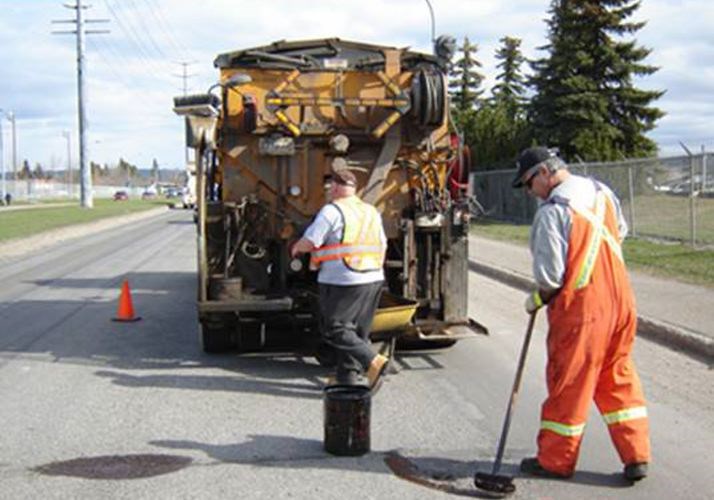The City of Prince George is examining building its own asphalt plant as a way to combat the city's perennial pothole problem.
Coun. Brian Skakun said the city needs to find creative ways to tackle its road maintenance.
"We can't get at the potholes early enough. Having our own small asphalt plant to allow us to get at repairing our roads much sooner in the year, preventing further costly decay of roads," Skakun said. "We need to think outside the box and look at ways to improve the way we do our road repairs."
The city needs to conduct an audit of what it is spending on road rehabilitation and look for more cost-effective ways of maintaining city streets, Skakun said.
"Simply increase taxes to repair and maintain our roads is not the only answer, and we cannot continue to put all the blame on the freeze-thaw cycles," Skakun said. "The road rehabilitation budget was seriously underfunded years ago and now we are paying the price."
The city also needs to ensure it is using best practices when repairing and paving roads in the city, he said.
"If you look at roads like Ospika, Domano, Foothills, University Way and others, the question needs to be answered as to why these roads have failed to the degree they have in a relatively short time," he said. "How do we patch potholes, are they sealed good enough to last or are spending money to get many of the same potholes filled year after year?"
Other cities including Winnipeg, Edmonton and Sudbury, Ont. operate their own asphalt plants as a way of controlling asphalt costs and having year-round access, city superintendent of operations Bill Gaal.
Gaal said the city is conducting very preliminary research into the concept.
The City of Thompson, Man. operated its own asphalt plant until provincial licensing regulations changed in 2010, Thompson director of public works Wayne Korversky said.
"We did decommission the plant this year, because of environmental [licensing] issues," Korversky said. "We'd definitely look at it again. I'd rather have a plant than buying the product. We're at the mercy of the contractors. For us, it is a revenue maker too - we'd make it for contractors."
Thompson is a city of approximately 13,500 people in north-central Manitoba. The "Hub of the North" serves a large outlying population, similar to Prince George.
Thompson's asphalt plant cost $350,000 per year to operate and employee three people on a seasonal basis, Korversky said.
"When it was at peak season, we use to call it a 1,000 batches per season plant," he said.
Each batch from the plant was 1,625 pounds of asphalt.
"We'd start using it as soon as it stopped freezing overnight," Korversky said. "The guys [pothole crews] have definitely noticed a difference. We're bringing in cold mix by b-train now."
Prince George transportation manager Al Clark said he and roads division manager Mick Jones are always open to ideas or products to tackle the pothole problem.
"We're open to any suggestions. If somebody's got a new product, we'll take a look and try it," Clark said. "[But] we've had a lot of experience and tried a lot of things."
Currently the city's preferred method involves using hot mix, either cold mix heated in the city's pothole trucks or hot mix from asphalt plants, he said. When the pothole is dry, it is cleaned out, sprayed with tack oil and hot mix is placed in the hole and compacted.
"We use a roller, leaving it a little bit high so vehicles driving on it do the final compaction," he said.
During winter when the ground is wet or frozen, cold patch is used and compacted into the hole using a truck tire, he said.
As of May 3, city staff had done 630 cold patch pothole repairs and 3,360 hot patches this year, city transportation manager Al Clark said. In addition, 301 metres of cracked pavement had been repaired.
In 2010, city crews patched 21,346 potholes --including 3,485 temporary cold patches. In addition, crews patched or sealed almost 22 km of cracks in city pavement and overlaid 4,251 square metres of damaged streets.
The city currently has three pothole patching trucks. Crews operate the trucks 16 hours a day, in two shifts.
Until the asphalt plants open later this month, one truck must be in the shop heating material each shift while the other is out working, he said.
Each truck carries six tonnes of asphalt fill, he said, and each shift the crews use up all the material in the truck.
The city has experimented with injection patching, Clark said. Injection patching uses a specialized truck which blows water and debris out of the pothole with hot air, then oil is sprayed in, followed by a granular mix.
"YRB has a spray-patch truck which we tried last year on Massey," Clark said. "Acme [Parking Lot Maintenance] has a trailer, older technology. We tried that on Domano, both lanes actually, but it didn't really do what we'd expected it to do."
Several companies produce high-performance cold mix patching material, which the city has also experimented with.
"There was a material that comes in a five-gallon pail - it was great stuff, but the cost was quite expensive," Clark said. "We use bulk."

.png;w=120;h=80;mode=crop)

